Commemorating Tragedy, Celebrating Recovery
After one year of forced rest, Roppongi Art Night (RAN) returned with a vengeance. Last year’s edition was cancelled at the last minute because of the Great East Japan Earthquake. To remember the disaster in Tohoku, this year’s theme was “Let’s revitalize Japan with Art,” and indeed, most of the participating artists decided to commemorate the tragedy.
Part of the Tokyo Culture Creation Project, this gigantic event was organized by the Tokyo Metropolitan Government together with Roppongi’s own local art museums, shopping association, galleries and the support of the national government’s Agency for Cultural Affairs.
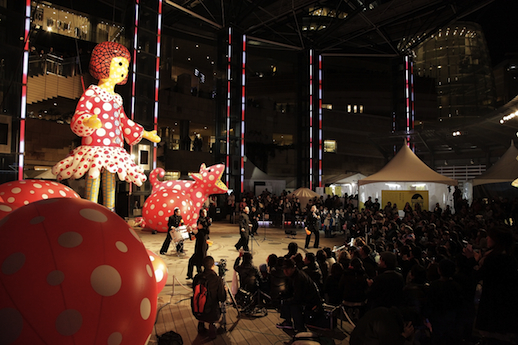
In the last few years Roppongi has raised its artistic pedigree through the establishment of several major museums and galleries (most of them staying open later than usual for the occasion), and every year the district takes this chance to turn itself into a no-holds-barred circus crammed with artistic works, music, film and – this year – even three “walking actors” roaming the streets and entertaining passersby. These street performances in particular were a rare chance to enjoy a kind of entertainment that is conspicuously absent in Japan.
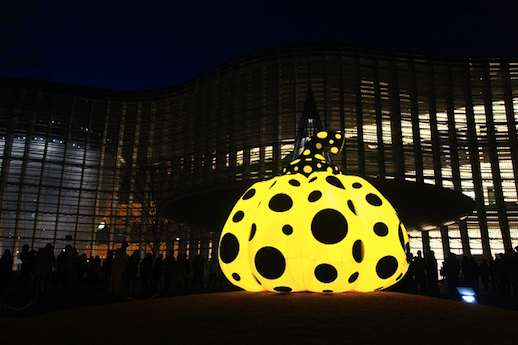
Between hardcore art lovers and people who simply wanted to have a good time, even this time RAN attracted a huge number of visitors. About 700,000 people in total viewed all the events in 2010 which is amazing when one considers that it only lasts for less than 48 hours. This year there was little hope to break that record because of the bad weather, but the gods of art got rid of the clouds and the rain just in time for the grand opening, when red-wigged Yayoi Kusama magically appeared. Earlier this year, the usually reclusive “good witch” of contemporary Japanese art had travelled to London to attend the opening of her current major retrospective at the Tate Modern, so everybody was expecting her appearance in Roppongi as well. Luckily she did not disappoint her many local fans. At around 6:00 p.m. her alter ego, 10-meter-high doll ‘Yayoi-chan’, literally stood up in the middle of the Roppongi Hills Arena and together with her giant inflatable dog, ‘Ring-Ring’, signaled the start of the festivities. Kusama is best known for her mesmerizing “infinity nets” paintings and playful polka-dot-themed installations. For the occasion, many of her works were scattered around Roppongi, including a massive three-meter-high version of her famous pumpkins. Particularly striking was ‘Footprints of Life’, a group of black-dotted pink balloons that seemed to float in the pitch-dark Tokyo Midtown lawns.
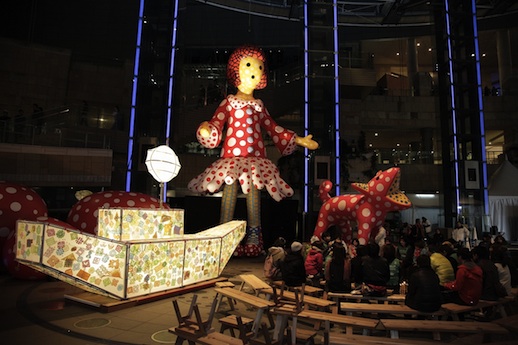
Just beside them, a couple of merry mice were trying to convince the usually shy passersby to carry their Jappy portable Shinto shrine around the district. This was part of Antenna’s ‘Legend of Roppongi 2012’ project. The playful Kyoto-based artist collective often explores the connections between Japan’s traditional and contemporary cultures. The Jappy mouse itself sported yellow skin, the Hinomaru national flag on top of its head, a Japanese pickled plum as its nose, and Mt. Fuji depicted on its stomach. For the occasion Antenna created the Rokuyo-do, a giant structure which, mixing the sacred and the profane, evoked a Japanese temple. Although far from being disrespectful, the artists explained that the project’s significance lied in the act of celebration. Holding a festival is both a way to commemorate past events and celebrate the recovery of a community, the Jappy mikoshi was meant to channel people’s prayers to “make Japan happy.”
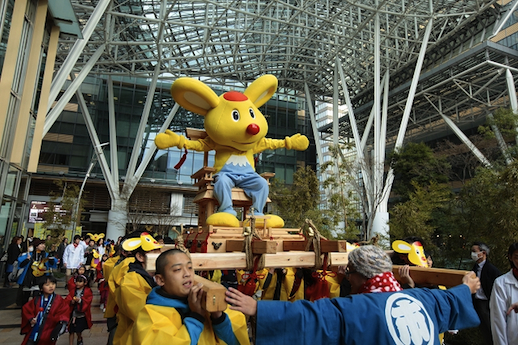
In the meantime, back at Roppongi Hills, the Arena had become a madhouse, with DJs spinning their plates, and thousands of people hunting for the stamps that would allow them to get one of Kusama’s prized mufflers. The festival atmosphere, enhanced by dozens of stands selling food and drinks, submerged in its own chaotic joie de vivre some interesting works, like Katsuhiko Hibino’s “Tohoku Koyomi no Yobune” (Night Boats of the Tohoku Calendar), a group of lantern-like boats made of Ishinomaki Japanese paper featuring colorful traditional designs, that according to the artist were meant to convey messages from Roppongi to the victims of the disaster.
A few meters removed from the central plaza, a group of balls were hovering above a pond, constantly changing color while emanating a mysterious sound. Somehow these so-called Floating Musical Instruments born out of a collaboration between teamLab and Hideaki Takahashi, managed to make people forget the ruckus coming from the nearby Arena.
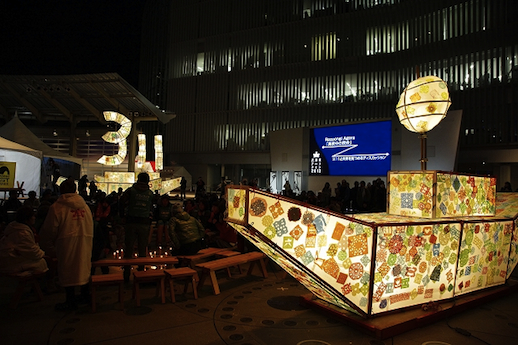
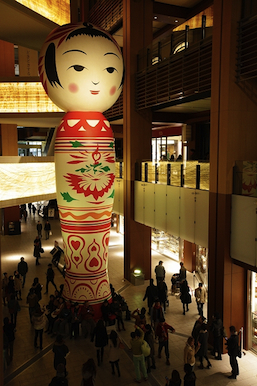
Everybody, though, seemed more intent in having a good time, and RAN certainly offered them many chances to enjoy the warm evening even outside the two main poles of attractions, with colorful plastic crocodiles gyrating near the main Roppongi sidewalk, light shows, big diamond rings hiding small birds and other objects, a number of workshops open to the general public, and the ubiquitous street performances.
Randy Swank
Escaped from his home country in 1992 and found refuge in Japan, where he promptly found a job teaching people how to shout HELP! and avoid being robbed on foreign buses. Since 1997 he has been unhealthily active in the mail art network, unleashing on the unsuspecting public, among other things, the Treatise of Pataphysical Anatomy and the international fake political campaign poster project. When not running after his two kids and from his wife, he is usually busy making zines (one of them is about Tokyo and all things Japanese), writing for high- and lowbrow magazines, and exploring Tokyo. You can read his uncensored, Gonzo-like adventures in Artland at The Randy Reviewer. See other writings
Tokyo Culture Creation Project
Tokyo Culture Creation Project



